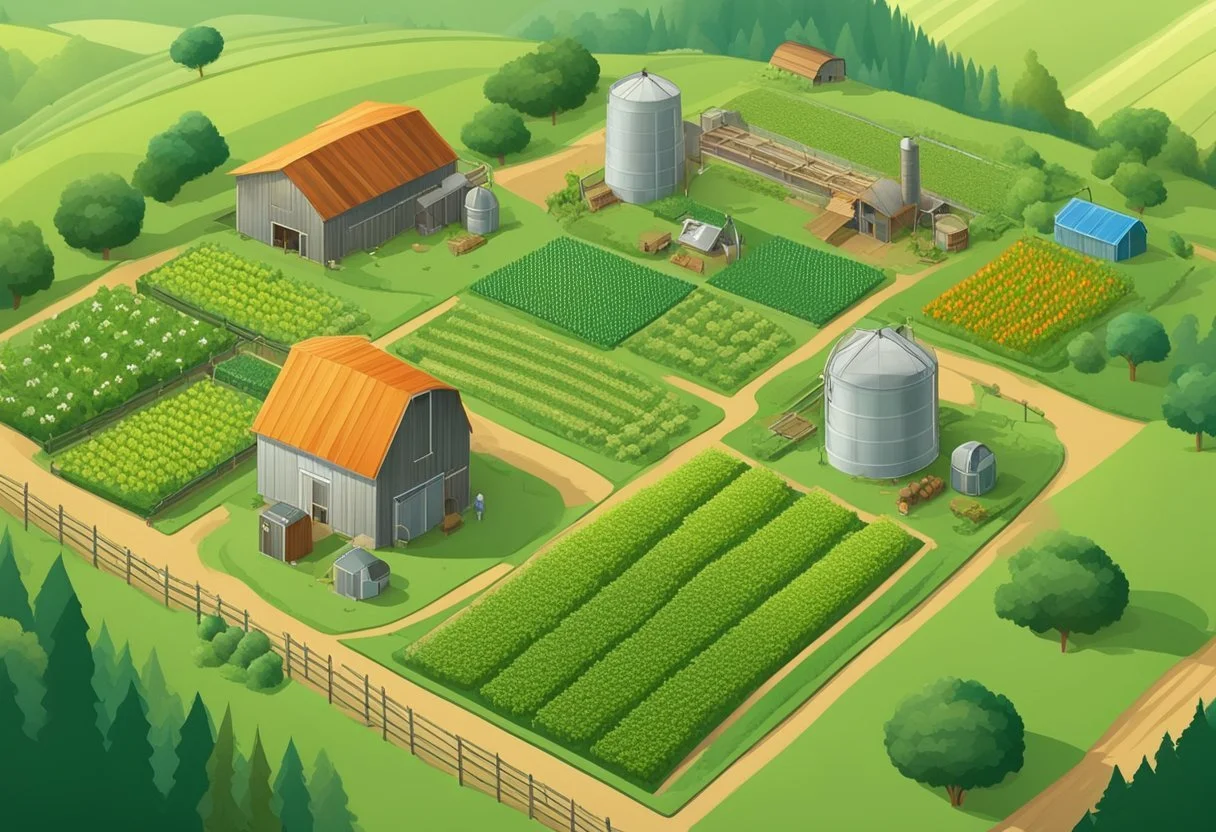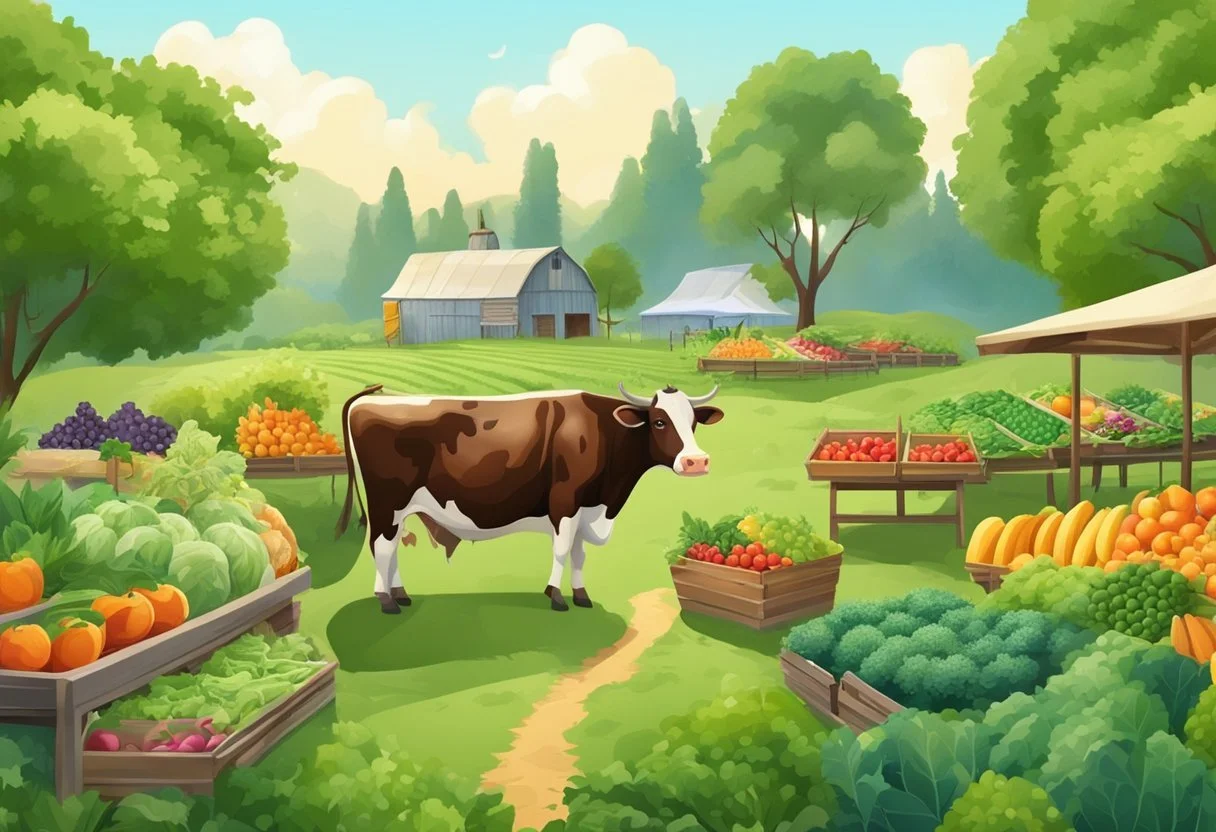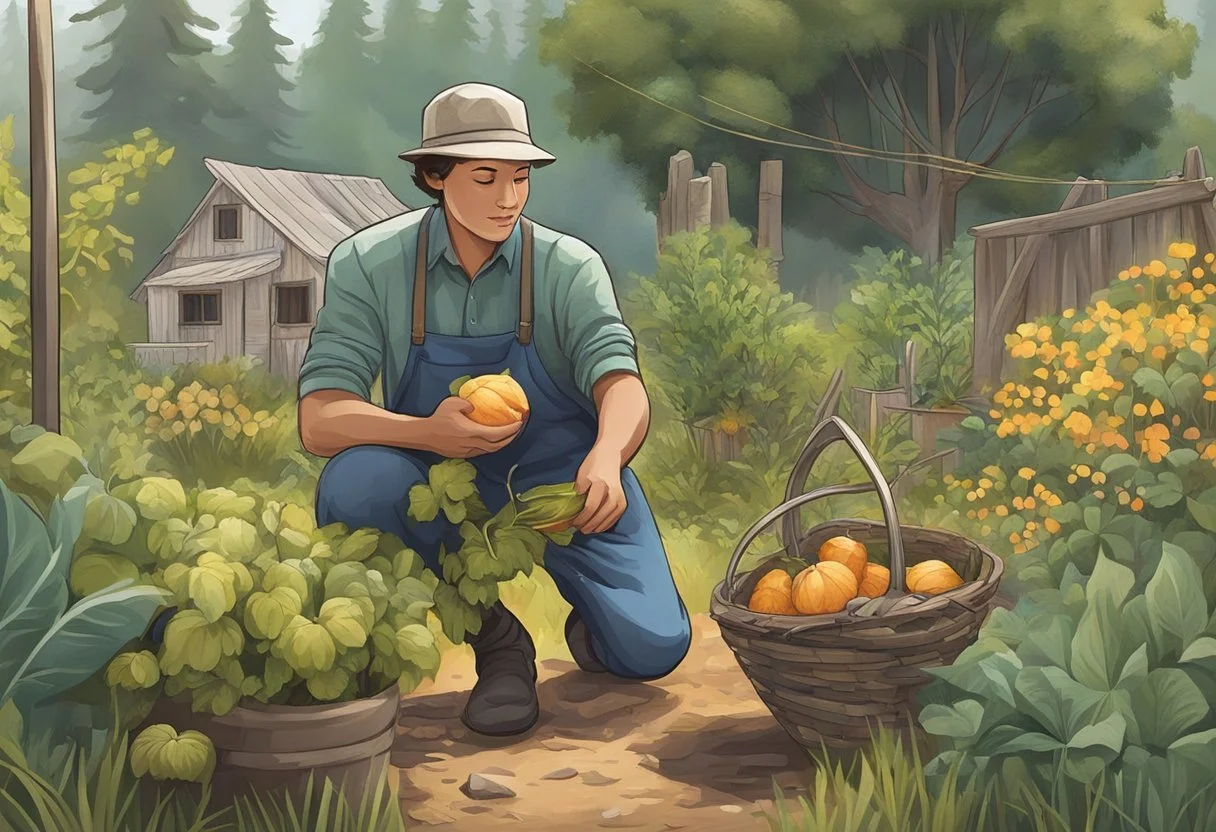Foraging for Homesteaders
Sustainable Practices for a Thriving Homestead
Discover > Homesteading > Foraging for Homesteaders
Living off the land is a lifestyle choice that revolves around utilizing nature's offerings for survival and self-sufficiency. This way of life incorporates harvesting resources such as food, water, and power from the land itself. Adopters of this lifestyle grow, hunt, and forage for their food, while harnessing power from the sun, wind, or other renewable sources. Water typically comes from wells, springs, or boreholes, ensuring a self-sufficient and environmentally conscious approach to living.
The practice of living off the land can also be referred to as homesteading or off-grid living, seeking minimal reliance on modern technology and society. It serves as a pathway to reconnecting with nature and attaining a sense of independence. While this may seem challenging to some, it can be a deeply rewarding experience that promotes sustainability and well-being.
Adopting this lifestyle typically involves building a home using reclaimed or eco-friendly materials, implementing self-sustaining energy systems, and then cultivating crops and livestock for personal consumption. By learning to live off the land, individuals can develop valuable skills and a greater appreciation for their world, while reducing their dependence on traditional supply chains and mass-produced resources.
Understanding The Concept
The idea of living off the land has its roots in traditional subsistence practices. To live off grid revolves around obtaining food, shelter, and other necessities directly from the environment. Some traditional tasks in this lifestyle include hunting, fishing, foraging, gardening, and animal husbandry. In addition, living off the land often involves using renewable energy sources like solar or wind power to generate electricity.
It comes down to personal choice just how self-sufficient you become. Some may choose to incorporate certain tasks of this lifestyle into their daily lives, such as growing a vegetable garden or raising chickens for eggs. While others may choose a holistic approach, striving to become entirely self-reliant by producing all of their food, water, and energy needs.
The benefits of living off the land are numerous:
Reducing environmental impact by consuming less, reusing resources, and minimizing waste
Enhancing physical and mental well-being through regular outdoor activities, a more positive outlook and a healthier diet
Strengthening community bonds by fostering cooperation and sharing resources
Developing valuable skills such as resourcefulness, adaptability, and practical knowledge.
However, this lifestyle is not without challenges. Self-sufficiency requires dedication, time, hard work, and a willingness to learn from both success and failure.
Selecting Your Location
When choosing a location for living off the land, several factors come into play. Consider aspects such as the land itself, climate, terrain, and available resources. The right location can make all the difference in effective self-sufficiency.
An essential feature of the land is its soil quality. Rich, well-drained soil will grow crops and maintain a healthy garden. Look for plots with fertile soil, native vegetation, and good drainage. Additionally, check for potential pollutants, such as heavy metals or toxic chemicals, that might affect plant growth.
The area climate greatly impacts the types of crops you can grow and the animals that can thrive there. Research average temperatures, precipitation levels, and the duration of growing seasons to ensure that it's suitable for your proposed crops.
Regarding terrain, a balance between flat and sloped land is beneficial. Flat areas are suitable for crop cultivation while sloping sections are ideal for water drainage and taking advantage of sun and wind exposure for generating power.
Access to resources is a crucial consideration when selecting your location. These resources include water sources, wood for construction and heating, and nearby towns offering the potential for bartering and networking with like-minded people. A natural water source, such as a spring, well, or river, is vital for irrigation and consumption.
Lastly, the views surrounding your chosen location can play a significant role in your overall well-being. Serene landscapes and natural beauty contribute to a peaceful and rewarding off-the-grid lifestyle.
Homesteading Basics
Homesteading revolves around having a self sufficient life. It originated from U.S. government legislation that provided free land to people who took over large tracts of rural land and turned them into their primary residences. Living off the land refers to the ability to survive only using the resources available from the natural land, such as food, water, and power, mainly harvested from sources like the sun or wind.
Aspiring homesteaders must understand the components of this lifestyle, which include:
Growing and preserving food: Establishing a garden is crucial for an effective off grid life. Plant varieties of fruits and vegetables that grow well in the local climate. Smaller livestock like chickens or rabbits can provide eggs, meat, and even manure for fertilizing the soil. Learning preservation techniques like canning or dehydrating will help maintain the food supply.
Water management: A reliable water source is vital for both drinking and irrigating the crops. Collecting rainwater, digging wells, and utilizing nearby streams can satisfy water needs. Developing water conservation methods and purification are important for a successful homestead.
Energy production: Off-grid living requires generating and managing energy independently. Solar panels, wind turbines, and micro-hydropower systems can produce electricity, while wood stoves or geothermal systems can offer heating and cooking energy.
Shelter and infrastructure: Constructing a comfortable, energy-efficient shelter is significant in creating a homestead. Incorporate sustainable building materials and methods like straw bale, cob, or reclaimed materials. Additional infrastructure could include fencing, animal shelters, and storage spaces.
Waste management and recycling: Efficient waste management helps maintain a clean and sustainable living environment. Composting systems, repurposing materials, and practicing responsible livestock waste disposal will minimize the ecological impact of the homestead.
Food and Nutrition
Land living involves a holistic approach to food and nutrition, where you rely on the surroundings for necessary sustenance. This lifestyle requires mastering gardening, foraging, and utilizing a variety of edible plants to maintain a balanced diet.
One of the cornerstones of living off the land is gardening, enabling individuals to grow their own fruits and vegetables. By cultivating a thriving garden, one can have a steady supply of fresh, organic produce. Common crops grown in self-sufficient gardens include tomatoes, potatoes, beans, peas, and leafy greens. These plants will ensure a well-rounded diet, providing nutrients, vitamins, and minerals.
Foraging is also critical, requiring skill and knowledge to identify, harvest, and consume wild edible plants. Examples include wild berries, mushrooms, nuts (how long do nuts last?), and edible greens. However, care is needed when foraging, as misidentifying plants could be harmful. Always use a reputable field guide to ensure proper identification.
It's important to be diligent in balancing your diet. A nutritious diet relies on:
Fruits and vegetables: Rich in vitamins, minerals, and fiber.
Protein sources: Beans, peas, and other legumes, as well as fish and game hunted locally.
Healthy fats: Obtained from nuts, seeds, and cold-pressed oils.
Complex carbohydrates: Derived from whole grains and starchy vegetables such as potatoes and squash.
In addition to these components, other plants and herbs can be used for teas, seasonings, and natural remedies.
Water Requirements
While living off the land, a reliable and clean water source is crucial for health and hygiene. This section outlines elements in obtaining and purifying water for off-grid living.
It is vital to identify a sustainable water source near the homestead. Natural water sources include:
Rivers and streams
Lakes and ponds
Wells and springs
Consider the proximity and accessibility of these water sources and the long-term sustainability of the source, as they will be fundamental to the feasibility of your off-grid lifestyle.
Once identified, proper treatment and purification is required for safety. Different water sources may require specific purification. Techniques in purifying water are:
Boiling: Kill microorganisms and pathogens by heating water over a fire or a gas stove.
Filtration: Mechanical filtration using filtration devices or homemade filters by stacking sand, gravel, and charcoal.
Chemical treatment: Adding chlorine or iodine tablets, drops, or crystals.
Ultraviolet (UV) light: Exposing water to UV light, from sunlight or UV lamps, destroys microorganisms' DNA.
Regularly monitoring your water source's quality is crucial, particularly after heavy rainfalls. Contamination from chemicals, runoff, or sewage can compromise the purity of water.
Establishing a Shelter
When embarking on a journey to live off the land, one essential aspect of self-reliance is having a proper shelter that provides safety and comfort in the wilderness.
A well-constructed shelter should be durable and well-insulated and able to withstand wind, rain, snow, and heat. Build your shelter according to the local climate and environment. The materials used for the shelter should be readily available locally. Be resourceful and utilize resources like wood, stones, and clay, as they offer functionality affordability, and they are eco-friendly.
Secure a reliable water source for your shelter, as this directly impacts your quality of life off the grid.
Choose a site for your shelter that is secure and accessible yet secluded enough for privacy. Consider elevation, proximity to food sources (wild game, fishing, and foraging). Keep safety in mind as well, regarding local wildlife, natural hazards.
Power Solutions
Living off the land requires utilizing sustainable and eco-friendly energy. These are options to generate power, which can be tailored to individual needs.
Solar power is popular for off-grid living, as it harnesses free energy from the sun using solar panels. The solar panel energy is converted into electricity, which is stored in batteries. Solar panels are eco-friendly, low-maintenance, and can generate electricity even on cloudy days. However, the initial costs can be high, and the system efficiency can be affected by the location and set-up.
Another option for off-grid power is wind energy. Wind turbines generate electricity by capturing the wind's kinetic energy and converting it into electrical power. Wind turbines need space and consistent wind, making them suitable for rural settings. Smaller wind turbines are also available for off-grid homes with lower energy demands.
Hydropower is another sustainable energy source utilizing flowing water to generate electricity. A small-scale hydroelectric system can be installed by rivers or streams, converting water flow into electricity. Hydropower provides a constant energy supply and can be combined with other renewables.
Energy efficiency also plays a role in off-grid living. These tips will maximize the efficiency of your off-grid home:
Insulate your home to maintain regulate temperatures and reduce energy consumption.
Use energy-efficient appliances and LED lighting to reduce demands.
Implement a power management system to monitor and regulate the use of electricity.
Cultivating a Garden
Planning and Location: When planning a backyard garden choosing the best location is vital. Find an area with well-drained soil and a minimum of six hours of full sunlight1. Be sure to check for both natural resources and any potential hazards before deciding on a site.
Soil Preparation: Prepare the soil by testing its pH levels and adjust accordingly with organic matter or lime. Composting is a vital part of maintaining soil fertility, which promotes healthy plant growth. Converting organic matter such as kitchen scraps and yard waste into compost helps recycle nutrients and improve soil structure2.
Plant Selection: Consider growing a variety of fruits and vegetables to provide balanced nutrition. Include wild berries to encourage local pollinators and birds. Research plants that are suitable for your locality and cultivate them accordingly.
Sustainability Practices: Implement permaculture principles for sustainability. Such as:
Crop rotation to maintain soil fertility and reduce pests
Companion planting to benefit neighboring plants and attract beneficial insects
Rainwater harvesting for irrigation
If you have an abundant crop some years sell the excess at a local farmer's market to create enough money for useful income.
Footnotes
Off Grid World, "Growing Your Own Survival Garden" ↩
A Comprehensive Guide to Self Reliance, "Living Off The Land" ↩
Hunting, Fishing, and Trapping
Hunting, fishing, and trapping are three essential skills for living off the land. The effectiveness of these activities will vary by local environment and wildlife.
Hunting is focused on capturing big and small game. It requires a good understanding of animal behavior, tracking skills, and using tools like firearms, bows, and knives. It's important to be mindful of local wildlife populations and their breeding cycles, so that hunting is responsible.
There are various fishing methods like using rods, nets, or spearfishing. Learn about the types of fish available locally. Fishing should also be done sustainably to maintain healthy fish populations.
Trapping targets small game animals, such as birds, rodents, and other mammals. Equipment ranges from homemade snares to box traps and conibear traps. Trapping requires patience, and a good understanding of animal habits. Always check local laws and regulations regarding the use of traps.
Keep in mind the following points when hunting, fishing, and trapping:
Familiarize yourself with local wildlife and habitats
Keep up on local laws and regulations regarding hunting, fishing, and trapping
Always think sustainably and respect the local ecological balance
Equip yourself with the knowledge and tools to practice these skills safely and effectively
Combine all your skills to more effectively live off the land
Raising Livestock
In raising livestock, managing and maintaining different animals, homesteaders can gain resources like food, milk, eggs, and even fertilizer. These are three popular livestock choices: chickens, goats, and rabbits.
Chickens are versatile for small-scale homesteaders producing egg and meat. They are low maintenance and adapt to small spaces. Popular breeds include Rhode Island Red, Plymouth Rock, and Sussex. Chickens also help with pest control, eating insects like mosquitoes and spiders. Chickens need simple housing, feed, and water, and protection from predators.
Goats Goat milk can be consumed as-is, or used in producing various dairy products. Goats also graze continually, helping with land management. They require proper fencing, housing, and access to clean water, and health checks to prevent diseases. Popular goat breeds for milk production include Nubian, Alpine, and LaMancha.
Rabbits are another viable livestock option, providing both meat and valuable fertilizer. Rabbit meat is lean and nutrient-dense, making it a healthy protein source. They reproduce quickly and need little space, making them ideal for homesteads. Rabbits need proper nutrition, access to fresh water and clean housing.
Managing Resources
Effectively managing natural resources like wood, timber, and firewood is crucial for sustainability and self-reliance. Consider the following best practices:
First, ensure responsible foraging and harvesting of wood and timber. Conserve forested areas by only taking what is needed and replant where possible. Utilize fallen branches as your primary source of firewood, to minimize the impact on the ecosystem.
Practicing responsible forest management ensures a continuous wood supply. For timber production, consider selective cutting techniques to allow younger trees to grow, and create a diverse ecosystem.
Another important aspect is proper water management. Living off the land often means relying on natural sources like rivers, springs, or wells. Use water efficiently and protect the quality of your water source. Use rainwater harvesting and water-saving techniques, such as drip irrigation, in your garden.
Manage your natural resources by:
Create a resource map of your property - identifying locations and quantities of the resources.
Develop a resource management plan to outline short-term and long-term goals and define the practices to achieve those goals.
Regularly monitor your resources and revise your management plan, to ensure ongoing sustainability and self-reliance.
Cooking and Preserving Food
Cooking and preserving food are essential skills for maintaining a sustainable and healthy lifestyle. Without modern appliances, traditional methods are the best alternatives for food preparation and storage.
Construct a simple fire pit to provide the heat you need. Dead branches and twigs are the primary sources of fuel. For a hotter flame, consider using hardwoods like oak or maple.
The key to cooking over a fire is mastering the control of heat. Create a temperature cooking gradient by arranging some wood on one side of the pit and more sparsely on the other. Cast iron cookware is a valuable addition to your off-grid kitchen, as it retains heat evenly and it lasts.
Food can be preserved in several ways:
Drying: Dehydrating fruits, vegetables, and meats keeps them fresh for extended periods without refrigeration. Lay out thin slices on a clean surface in a warm, well-ventilated area, or use a solar food dehydrator.
Canning: Cooked food is packed into sterilized jars and heated in a hot water bath or pressure canner to kill bacteria. The vacuum seal created keeps the food safe for long-term storage.
Pickling: Soaking food in vinegar slows down bacterial growth and tenderizes the food. Mixtures of vinegar, salt, and spices can create a variety of flavors.
Fermenting: Natural bacteria present in food consume sugars and produce lactic acid aids in preservation. Common fermented foods include sauerkraut (how long does sauerkraut last?), kimchi (how long does kimchi last?), and yogurt.
Cold storage: Utilizing a root cellar or insulated storage area can reduce temperatures enough to prolong the shelf-life of produce.
Survival Skills
When living off the land, survival skills are an essential part of safety and being self-reliant . This section discusses first aid, problem-solving, and the tools needed for a successful off-grid lifestyle.
First Aid: Accidents and injuries are inevitable when living off the land, so be prepared. Have a well-stocked first aid kit and familiarize yourself with first aid procedures, such as:
Cleaning and dressing wounds
Handling fractures and sprains
Treating burns, bites, and stings
Identifying and managing symptoms of dehydration and heatstroke.
It is also advisable to take a wilderness first aid course, which focuses on specific outdoor-related injuries and illnesses.
Problem-Solving: In a remote lifestyle, its necessary to troubleshoot and employ problem-solving skills. A few key areas include:
Identifying edible plants and mushrooms
Finding and purifying water sources
Building and maintaining shelter
Using natural resources for heating and cooling
The ability to approach problems with a clear mind and practical approach is invaluable when living off the land.
Basic Tools: Having a selection of tools at your disposal is crucial. Some basic tools to include:
A sturdy, sharp knife for cutting, carving, and processing food and a knife sharpener
A saw or hatchet for cutting firewood and building materials
A spade or shovel for gardening and sanitation purposes
A water filter or purification tablets for safe drinking water
A compass, map, and signaling equipment in case of getting lost
Remember that in a survival situation, it is often the simplest tools that prove to be most versatile and valuable.
Preparation and Planning
Thorough preparation and planning are crucial to ensure a successful and sustainable lifestyle on the land.
Gather knowledge about the local climate, geography, and soil types. Use local government websites, agricultural departments, and regional research papers for research. You can then determine the best crops to grow and the ideal locations for water, animal husbandry, and shelter.
Some primary aspects to research and plan for:
Local climate and weather: Understand the seasons, average rainfall, temperature variations, and natural disasters that may affect the region.
Soil type and quality: Identify the soil composition, drainage, and fertility to select appropriate crops and cultivation methods.
Some infrastructure elements to include:
Housing: Consider the local building materials and long-term durability.
Energy sources: Evaluate the potential for solar, wind, or other renewable energy sources.
Water sources: Determine the availability of surface and groundwater, and the need to create wells or rainwater harvesting.
Another essential aspect of planning is skill development. Gain knowledge in core areas such as:
Gardening and farming techniques
Animal husbandry
Basic construction and woodwork
Wilderness survival
First aid
Dealing with Challenges
Living off the land can be a rewarding and fulfilling experience. However, it comes with its own challenges that must be overcome. With hard work, dedication, and proper planning, navigating such hurdles and maintaining sustainability and self-sufficiency is possible.
Safety is a primary concern when living off the land. A proper understanding of potential dangers is essential, including how to handle wild animals, proper use of tools, and knowledge in first aid. It is crucial to have a well-stocked first-aid kit.
The hard work involved in living off the land should not be underestimated. Tasks such as planting crops, maintaining a garden, raising livestock, and general property maintenance require significant physical labor.
Dedication to this lifestyle choice is necessary for success. Learning new skills takes continuous effort and commitment. Allocate time for self-learning to become more resourceful and efficient.
One of the significant challenges of living off the land is dealing with loneliness and isolation. To maintain mental well-being, staying connected with friends and family is essential. Embrace the use of technology, such as video calls or social networks, to keep in touch with loved ones.
Here is a summary of the challenges discussed and potential solutions:
Financial Considerations
Before embarking on a journey to live off the land, it is crucial to understand the financial implications and make informed decisions. This involves costing land purchase, building a suitable shelter, and managing day-to-day living costs and taxes.
One of the initial expenses is the cost of acquiring land suitable for being self-reliant. Prices vary depending on the location, acreage, and accessibility. Performing thorough research on the land's market value, and considering its resources, such as water availability and soil fertility, helps in making a sound investment.
Once the land is acquired, the next major expense is building or setting up a suitable shelter. Depending on your preferences and budget, this could range from simple cabins to more elaborate eco-friendly homes. It is essential to bear in mind that sustainability and energy efficiency should be priorities when designing your off-grid home.
Some key infrastructure expenses to consider are:
Buy Land: cost per acre, taxes, and associated fees
Shelter: construction materials, labor, and permits
Energy system: solar panels, wind turbines, or other renewable energy sources
Water system: wells, water storage, filtration, and plumbing
Sewage system: septic tank or composting toilet
Here's a brief list of ongoing costs in being self-supporting:
Property taxes
Maintenance and repair costs for shelter and infrastructure
Food cultivation and preservation materials
Healthcare and insurance premiums
Transportation and fuel
Living off the land requires financial planning and a thorough understanding of both initial and ongoing expenses. By factoring in the costs related to purchasing land, building a shelter, and managing daily expenses, anyone seeking an off-the-grid lifestyle can be better prepared for this self-supporting journey.
Building a Self-Supporting Community
Living off the land and becoming self-supporting is a rewarding lifestyle. However, the journey to being self-supporting may be isolating and challenging at times. Therefore, building a self-supporting community with like-minded individuals plays a crucial role in achieving sustainable living practices and overcoming potential obstacles.
To create a thriving self-supporting community, the residents should exchange skills and knowledge. Members can arrange workshops or skill-sharing demonstrations, covering topics such as gardening, cooking, sewing, and basic repair work. They may use forums, social media platforms, or local groups to organize these events, enhancing collaboration among the community members.
An essential aspect of self-supporting communities is local food production. Communities that prioritize local agriculture and food production become more self-sufficient and less dependent on external sources. Encouraging members to grow their own food or develop a community garden is an advantageous approach. Besides, supporting local farmers, buying from local markets, and participating in food cooperatives are all valuable practices.
Furthermore, reducing waste and promoting reuse strengthens a self-supporting community. Initiating waste management programs, composting, and recycling are crucial steps in minimizing waste. Organizing events like clothing swaps, tool-sharing, or community repair workshops, further promote resourceful living.
Adopting alternative, renewable energy sources is another pillar of an off-grid, self-sustaining community. Harnessing solar, wind, and hydroelectric power, when feasible, can lead to complete energy independence. The community may share the initial investment and expertise required to set up such systems.
Finally, planning for sustainable community growth is an indispensable element of a self-supporting community. Strengthening ties with neighbors, local businesses, and municipal agencies ensures the long-lasting success and prosperity of the community.
The Freedom of Living Off The Land
Living off the land provides a sense of freedom in modern life that many people today long for. The concept revolves around self-reliance and the use of nature's offerings, such as vegetation, animals, and soil, for sustenance. This lifestyle encourages individuals to rely less on advanced technology or societal structures and instead, fosters a deeper connection with the environment.
By choosing to live off the land, individuals gain the opportunity to grow, hunt, or forage for wild plants which can lead to a greater sense of self-sufficiency. This is particularly rewarding for those who appreciate knowing the source of their meals and the quality of the ingredients. The availability of natural resources like plants, farm animals, and soil ensures that they fulfill their basic needs without heavily depending on modern conveniences.
Additionally, living off the land can offer a more sustainable approach to life. Many off-grid land dwellers employ eco-friendly options such as solar and wind power for their energy needs. This not only lowers their environmental impact, but also provides independence from utility companies and their often fluctuating rates.
In conclusion, there are several locations in the United States that provide ideal conditions for living on a family farm off the grid. Depending on personal preferences and climate tolerance, potential off-gridders can choose from a range of environments, each offering unique opportunities and challenges. The key is to research and plan accordingly to ensure a success








